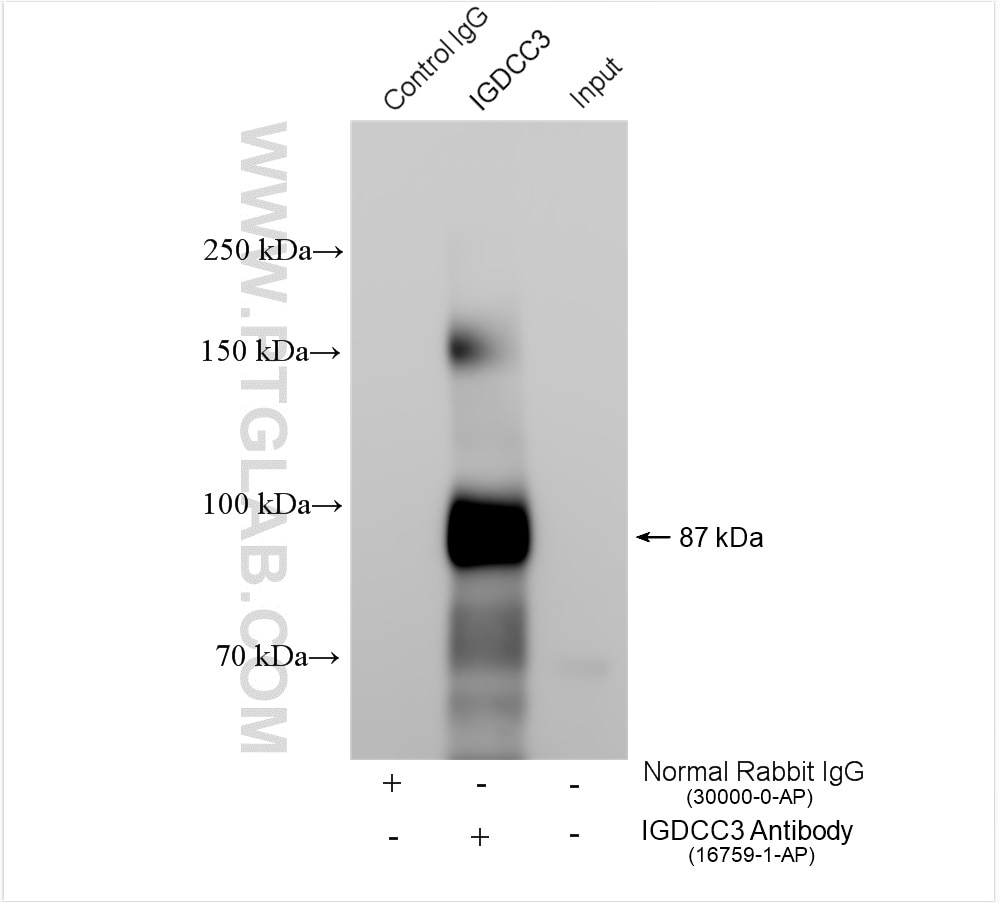IGDCC3 Polyklonaler Antikörper
IGDCC3 Polyklonal Antikörper für IP, ELISA
Wirt / Isotyp
Kaninchen / IgG
Getestete Reaktivität
human, Maus, Ratte
Anwendung
IP, ELISA
Konjugation
Unkonjugiert
Kat-Nr. : 16759-1-AP
Synonyme
Geprüfte Anwendungen
| Erfolgreiche IP | humanes Plazenta-Gewebe |
Empfohlene Verdünnung
| Anwendung | Verdünnung |
|---|---|
| Immunpräzipitation (IP) | IP : 0.5-4.0 ug for 1.0-3.0 mg of total protein lysate |
| It is recommended that this reagent should be titrated in each testing system to obtain optimal results. | |
| Sample-dependent, check data in validation data gallery | |
Produktinformation
16759-1-AP bindet in IP, ELISA IGDCC3 und zeigt Reaktivität mit human, Maus, Ratten
| Getestete Reaktivität | human, Maus, Ratte |
| Wirt / Isotyp | Kaninchen / IgG |
| Klonalität | Polyklonal |
| Typ | Antikörper |
| Immunogen | IGDCC3 fusion protein Ag10276 |
| Vollständiger Name | immunoglobulin superfamily, DCC subclass, member 3 |
| Berechnetes Molekulargewicht | 814 aa, 87 kDa |
| Beobachtetes Molekulargewicht | 87 kDa |
| GenBank-Zugangsnummer | BC067107 |
| Gene symbol | IGDCC3 |
| Gene ID (NCBI) | 9543 |
| Konjugation | Unkonjugiert |
| Form | Liquid |
| Reinigungsmethode | Antigen-Affinitätsreinigung |
| Lagerungspuffer | PBS with 0.02% sodium azide and 50% glycerol |
| Lagerungsbedingungen | Bei -20°C lagern. Nach dem Versand ein Jahr lang stabil Aliquotieren ist bei -20oC Lagerung nicht notwendig. 20ul Größen enthalten 0,1% BSA. |
Hintergrundinformationen
IGDCC3, also known as PUNC, is a transmembrane protein that belongs to the immunoglobulin (Ig) superfamily (PMID: 9507132). IGDCC3 contains 4 C2-type Ig-like domains and 2 fibronectin type III repeats. It is highly expressed in the developing embryo in nervous system, limbs, and inner ear (PMID: 9922388; 9507132). IGDCC3 may be involved in the cerebellar control of motor coordination (PMID: 11486040). It has also been associated with tumorigenic mechanism and prognosis of cholangiocarcinoma (PMID: 36979826).
Protokolle
| PRODUKTSPEZIFISCHE PROTOKOLLE | |
|---|---|
| IP protocol for IGDCC3 antibody 16759-1-AP | Protokoll herunterladen |
| STANDARD-PROTOKOLLE | |
|---|---|
| Klicken Sie hier, um unsere Standardprotokolle anzuzeigen |


